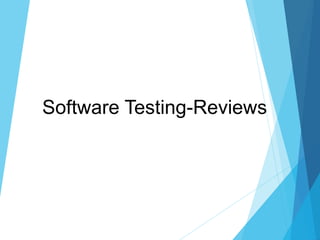This document discusses different types of software reviews including informal reviews, walkthroughs, and formal inspections. Formal inspections follow a defined process and are the most rigorous type of review. They involve preparation, inspection of the material by attendees to find defects, reworking defects, and follow up. Usability testing is discussed which involves testing a product with real users performing real tasks and observing them to identify usability issues. Methods like expert reviews and user testing are covered. Data is gathered during testing and analyzed to identify problems and inform recommendations.



























































